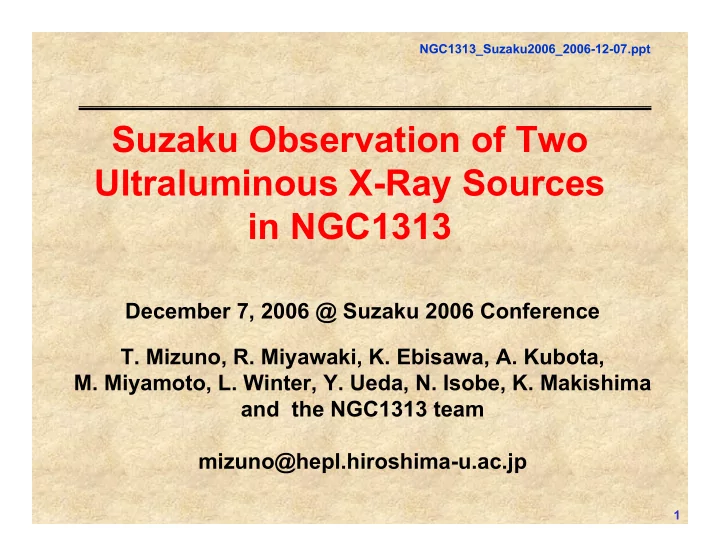

NGC1313_Suzaku2006_2006-12-07.ppt Suzaku Observation of Two Ultraluminous X-Ray Sources in NGC1313 December 7, 2006 @ Suzaku 2006 Conference T. Mizuno, R. Miyawaki, K. Ebisawa, A. Kubota, M. Miyamoto, L. Winter, Y. Ueda, N. Isobe, K. Makishima and the NGC1313 team mizuno@hepl.hiroshima-u.ac.jp 1
NGC1313_Suzaku2006_2006-12-07.ppt Ultraluminous X X- -ray sources ( ray sources (ULXs ULXs) ) Ultraluminous • X-ray sources with Lx>=3x10 39 erg/s : L edd >20M sun • Discovered by Einstein Observatory (Fabbiano 1989). Extensively studied by ASCA, XMM-Newton and Chandra (Makishima et al. 2000, Swartz et al. 2004, Stobbart et al. 2006) • Often associated with regions of start formation. • Show variability by a factor of ~5. • Two spectral states: PL and MCD (La Paroal et al. 2001, Kubota et al. 2001) • Promising candidate for intermediate-mass black holes (IMBHs). • Key to understand the black hole radiation in high accretion rate. Study of spectral change is important 2
NGC1313_Suzaku2006_2006-12-07.ppt Four Spectral States of Galactic BHBs BHBs Four Spectral States of Galactic Opt. thick McClintock & Remillard 2006 cool/truncated disk Kubota & Makishima 2004 Slim Disk High Luminosity Opt. thick high-temp disk Slim Disk Opt. thick Very High disk State PL with cutoff Very High State (disk photon Low Comptonization) High State State ULXs are important to verify the High State unified picutre of BH radiation Low State PL with PL thermal cutoff Low Luminosity 1 10 100 Energy(keV) 3
NGC1313_Suzaku2006_2006-12-07.ppt Suzaku observation of NGC1313 observation of NGC1313 Suzaku • Nearby face-on Sb XIS0 (0.3-10 keV) galaxy at d=3.7Mpc • Hosts three X-ray luminous sources X-1 • X-1 and X-2 have been extensively studied in SN1978K X-rays (twice by ASCA, 7 ′ more than 15 times by XMM and 8 times by Chandra. • Ideal target for ULXs study • Observed on 2005 October 15 X-2 for 90 ks (net exposure ~30 ks) Cal sources 4
NGC1313_Suzaku2006_2006-12-07.ppt X- -2: Light Curve/Spectra 2: Light Curve/Spectra X XIS(FI) Light Curve Unfolded Spectra HF Lx=6 x 10 39 erg/s LF HF phase LF phase XMM archival data MCD-type with 2003/12/21,12/23, 2005/2/7,2006/6/5 Tin=1.2-1.6 keV 2003/12/25 2000/10/17, 2004/1/8, 1/16 and 1/23 PL-type ( Γ ~2.2) (Miller et al. 2003; Feng & Kaaret 2006) 5
NGC1313_Suzaku2006_2006-12-07.ppt Time- -averaged Spectra of X averaged Spectra of X- -1/X 1/X- -2 2 Time Crab Ratio (arbitrary) XIS0 (0.3-10 keV) X-1 X-1 Lx=2.5 x 10 40 erg/s PL-like with HE cutoff X-2 X-2 Lx=6 x 10 39 erg/s MCD-like convex spectrum 10 1 Energy (keV) 6
NGC1313_Suzaku2006_2006-12-07.ppt Spectral Variability of X- -2 2 Spectral Variability of X • Intensity change by ~50% • Spectral change: hardens as the source gets brighter Suzaku BI spectra • HF phase: p-free • (Tin=1.86 keV, p=0.63, χ 2 /ν =151/143) X2 is in • HF phase: MCD Slim Disk State • (Tin=1.50 keV, 1Rin=80 km, χ 2 / ν =172/144) • LF phase: MCD • (Tin=1.24 keV, Rin=100 km, χ 2 / ν =72/76) 7
NGC1313_Suzaku2006_2006-12-07.ppt X- -1: Light Curve/Spectra 1: Light Curve/Spectra X Highest Luminosity ever observed (2.5 x 10 40 erg/s) Lx=2.5 x 10 40 erg/s HF LF HF phase XMM archival data Suzaku data: 2004/6/5 LF phase PL-type with HE cutoff 2003/12/21, 2004/1/8 and 1/17 2000/10/17 and 2005/2/7 Oct 17 2003/8/23 most of XMM data: PL-type with Γ =1.7-2.4 (Miller et al. 2003; Feng & Kaaret 2006) 8
NGC1313_Suzaku2006_2006-12-07.ppt Spectral Variability of X- -1 1 Spectral Variability of X • Spectrum changes above 1keV • Opposite to X-2: softens as the source gets brighter Contradict to Slim Disk prediction • Variable cutoff PL: dominate the spectrum comptonization • Stable coold disk (Rin=4000 km, Tin=0.2 keV): • p-free fit: disk truncated (or cooled) • p-free fit: HF phase: Tin=2.1 keV, p=0.60, χ 2 / ν =243/219 due to comptonization HF phase: Tin=2.1 keV, p=0.60, χ 2 / ν =243/219 LF phase: Tin=2.7 keV, p=0.51, χ 2 / ν =84/95 LF phase: Tin=2.7 keV, p=0.51, χ 2 / ν =84/95 • MCD+cutoffPL fit: Likely to be in the HF phase: Γ =0.9, Ec=3.4 keV, χ 2 / ν =240/218 Very High State LF phase: Γ =1.6, Ec=6.0 keV, χ 2 / ν =83/94 9
NGC1313_Suzaku2006_2006-12-07.ppt Note on BH mass Note on BH mass • X-2 is interpreted to be in Slim Disk State � L x is close to L edd � M edd ~50 M sun • X-1 is likely to be in the Very High State � L x <=L edd � M >=200 M sun � Even if a super-Eddington condition by a factor of 3 is allowed, M >=70 M sun is required. ULXs in NGC1313 are IMBH 10
NGC1313_Suzaku2006_2006-12-07.ppt Summary Summary • ULXs are promising candidates of IMBH. • Spectral change is a key to understand ULXs/BH radiation • Suzaku found intensity-correlated spectral changes from two ULXs in NGC1313 and strengthened the analogy to BHBs • X-1 and X-2 are interpreted to be in the Very High State dominated by Comptonization and the Slim Disk State shining close to the Eddingtion limit, respectively. • M >=50 M sun -> IMBH 11
NGC1313_Suzaku2006_2006-12-07.ppt BackUp Slides Slides BackUp 12
NGC1313_Suzaku2006_2006-12-07.ppt HR- -diagram of BHB/ diagram of BHB/ULXs ULXs HR L (erg/s) ULXs 10 40 NGC1313 X- 2 10 39 L ∝ T 4 L ∝ T 2 Standard Disk Advection Dominated Disk 10 38 (Slim Disk) Stellar mass BHs 13
NGC1313_Suzaku2006_2006-12-07.ppt Spectral Variability of X- -2 2 Spectral Variability of X • Intensity change by ~50% • Spectral change: hardens as the source gets brighter • Employ a p-free disk model to Suzaku BI spectra examine a disk temperature profile ( ) ( ) − p = T r T r / r in in � Standard disk (MCD): p=0.75 � Slim disk: p=0.75-->0.5 (Watarai et al. 2001) • HF phase: p-free X2 is in Tin=1.86 keV, p=0.63, χ 2 /ν =151/143 Slim Disk State • HF phase: MCD Tin=1.50 keV, 1Rin=80 km, χ 2 / ν =172/144 • LF phase: MCD (p=0.75) Tin=1.24 keV, Rin=100 km, χ 2 / ν =72/76 14
Recommend
More recommend